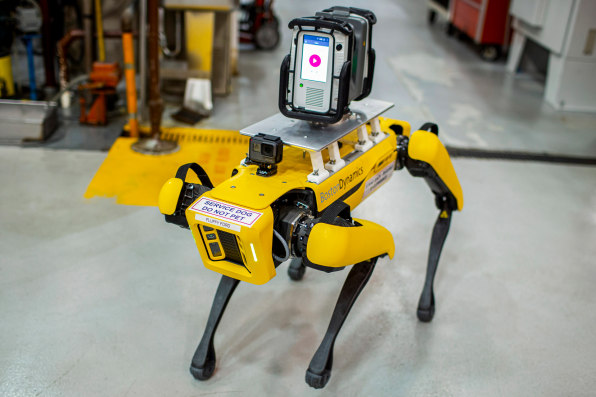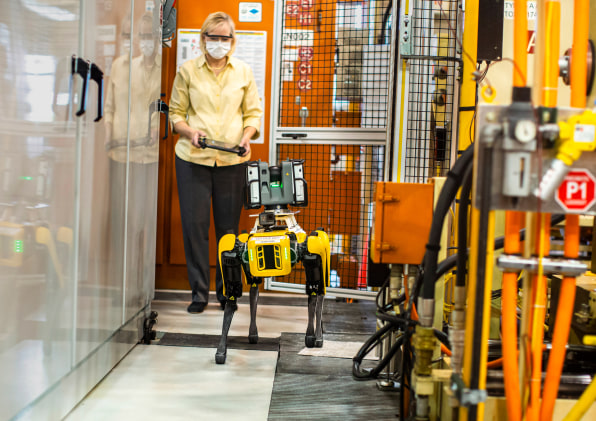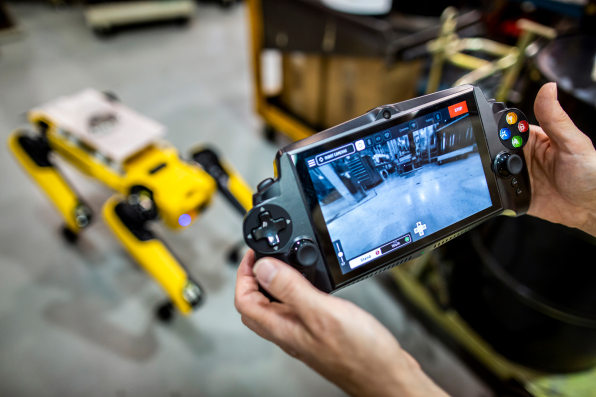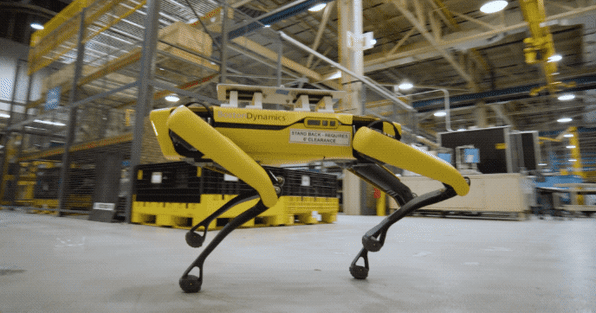How To Start Business In Robotic Animal For Ride
A couple years agone, the internet had a mild freakout when the robotics company Boston Dynamics showed off a dog-like robot opening the door for one of its pals. Twitter commentators chosen the demonstration "terrifying," "the end of us all," and a sign that "we're all dead."
Simply that little chip of robot collaboration was but the start for Spot, the robot Boston Dynamics has been leasing out for industrial use since last autumn. At present that Spot is out in the real world, Boston Dynamics has received "more than a few" requests to accept information technology team up with other robots, says Michael Perry, Boston Dynamics'due south vice president of concern development. The visitor is now allowing other businesses to purchase Spot outright, and has provided tools and so they tin integrate information technology with entire robot fleets.
"It's non just Spot riding on a wheeled robot, but we've had some customers looking at Spot conveying a drone, and the drone flies off the dorsum of the robot, does inspection of something that's high up, lands on the back of the robot, and continues on its mission," Perry says. "In that location are a lot of advantages and opportunities to explore the ways different types of automation tin can interact together."

As Boston Dynamics tries to transition abroad from its roots in government-funded research, making Spot play nice with other robots can help it ingratiate itself with businesses, which are increasingly asking for ways to make robots work together.
Wheels and legs
One of Boston Dynamics's showtime industrial customers is Ford, which has been testing Spot at both its Advanced Manufacturing Center in Redford, MI, and the UAW-Ford Technical Grooming Center in Dearborn, MI. Equipped with a laser scanner and 360-caste video camera, Spot has been capturing 3D images of parts, tools, and room layouts. Ford then turns the output into reckoner-aided pattern files and virtual reality programs, which it uses to retool its associates plants.

Spot doesn't work lonely, though. Ford too uses an autonomous wheeled robot to bulldoze around its facilities and capture its own images, sort of like a Roomba with a tripod and cameras sticking out of the top. (Ford came up with its own names for the two robots: Fluffy for Boston Dynamics'due south creation and Scouter for the robot on wheels.) Mark Goderis, a Ford digital engineering manager, says the pair can scan a three-one thousand thousand-square-foot facility in about a week, versus two weeks for the transmission process of capturing images on a stationary tripod, while as well reducing costs.
"The idea is . . . we'd take that in every one of our facilities to exist able to update scans whenever our employees need it," Goderis says. That mode, they can have upwardly-to-appointment views of how their facilities are laid out.
in Sterling Heights, MI.
"We're working to go Scouter and Fluffy to work together, so that Fluffy will ride on top of Scouter, and go around and do the scans, and then when Scouter can't get into a tight spot, we'll release the hounds," he says.
Boston Dynamics'southward Michael Perry says this is not an uncommon request, and and so the company has been working to accommodate what he calls "robot teaming."
In May, the company appear a new API, so that its partners can teach Spot new tricks, such as autonomous navigation. Perry says customers can also program Spot to coordinate with other robots or integrate with robot fleet management systems.

"It turns out that customers like Ford accept been deploying mobile robots in their facilities, but they've not been able to get the full coverage that they need, partly because of terrain challenges," he says. "And that's where this notion of pairing robots together is so powerful."
Rising of the machines
The push for industrial use represents a pin of sorts for Boston Dynamics, which is best-known for making DARPA-funded robots with potential armed services applications, such every bit BigDog and Atlas. (The visitor was caused by Google in 2013, then sold to the Japanese holding company Softbank iv years later.) Although Boston Dynamics is notwithstanding developing Atlas equally a manner to research robotic movements, it's no longer doing research or development for DARPA, and information technology's pushing Spot equally its first truly commercial product.
At that place's a sense that the company is trying to brand its robots seem a little less menacing in the procedure. Earlier this month, Spot served as a cheerleader for a baseball squad, and final week served as a fill-in dancer for the Japanese composer and developer Daito Manabe and the performing arts grouping Rhizomatiks on NHK Songs, a music prove in Nippon. Spot'due south trip the light fantastic moves aren't new, only information technology'south increasingly performing them outside of the lab.

And in case the idea of a robotic canis familiaris teaming up with other bots even so makes you nervous, Boston Dynamics insists outright that Spot won't go a killer pack animate being. While the company does non rule out police force or military applications such equally flop detection or hazmat response, its terms of service forbid using the robot for harm, threats, or intimidation, and it's not immune to even hold a weapon.
"In order for the robot to beneficial long-term, it has to be able to be trusted," Perry says.
This story has been updated to clarify that Spot can exist programmed to work autonomously, though information technology is not autonomous in Ford's implementation.
Source: https://www.fastcompany.com/90533566/at-ford-factories-boston-dynamicss-robot-dog-spot-is-teaming-up-with-a-new-robotic-friend
Posted by: hibbittsnuthat.blogspot.com

0 Response to "How To Start Business In Robotic Animal For Ride"
Post a Comment